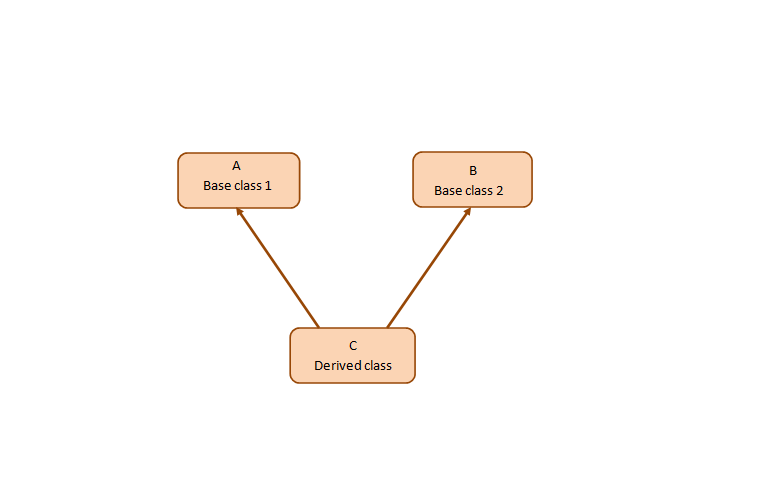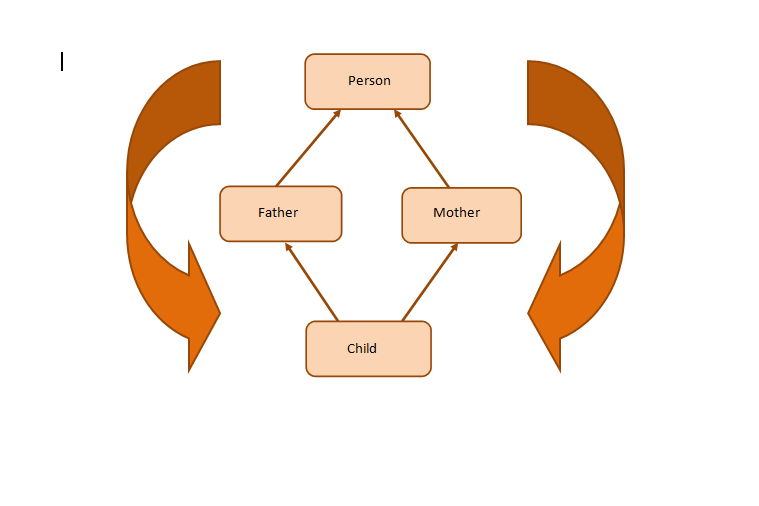Multiple inheritance in C++ is powerful, but a tricky tool, that often leads to problems if not used carefully—problems like the Diamond Problem.
In this article, we will discuss the Diamond Problem, how it arises from multiple inheritance, and what you can do to resolve the issue.
Multiple Inheritance in C++
Multiple Inheritance is a feature of Object-Oriented Programming (OOP) where a subclass can inherit from more than one superclass. In other words, a child class can have more than one parent.
The figure below shows a pictorial representation of multiple inheritances.

In the above diagram, class C has class A and class B as its parents.
If we consider a real-life scenario, a child inherits from its father and mother. So a Child can be represented as a derived class with “Father” and “Mother” as its parents. Similarly, we can have many such real-life examples of multiple inheritance.
In multiple inheritance, the constructors of an inherited class are executed in the order that they are inherited. On the other hand, destructors are executed in the reverse order of their inheritance.
Now let’s illustrate the multiple inheritance and verify the order of construction and destruction of objects.
Code Illustration of Multiple Inheritance
For the multiple inheritance illustration, we have exactly programmed the above representation in C++. The code for the program is given below.
#include<iostream>
using namespace std;
class A //base class A with constructor and destructor
{
public:
A() { cout << "class A::Constructor" << endl; }
~A() { cout << "class A::Destructor" << endl; }
};
class B //base class B with constructor and destructor
{
public:
B() { cout << "class B::Constructor" << endl; }
~B() { cout << "class B::Destructor" << endl; }
};
class C: public B, public A //derived class C inherits class A and then class B (note the order)
{
public:
C() { cout << "class C::Constructor" << endl; }
~C() { cout << "class C::Destructor" << endl; }
};
int main(){
C c;
return 0;
}The output we obtain from the above program is as follows:
class B::Constructor
class A::Constructor
class C::Constructor
class C::Destructor
class A::Destructor
class B::DestructorNow if we check the output, we see that the constructors are called in order B, A, and C while the destructors are in the reverse order. Now that we know the basics of multiple inheritance, we move on to discuss the Diamond Problem.
The Diamond Problem, Explained
The Diamond Problem occurs when a child class inherits from two parent classes who both share a common grandparent class. This is illustrated in the diagram below:

Here, we have a class Child inheriting from classes Father and Mother. These two classes, in turn, inherit the class Person because both Father and Mother are Person.
As shown in the figure, class Child inherits the traits of class Person twice—once from Father and again from Mother. This gives rise to ambiguity since the compiler fails to understand which way to go.
This scenario gives rise to a diamond-shaped inheritance graph and is famously called “The Diamond Problem.”
Code Illustration of the Diamond Problem
Below we have represented the above example of diamond-shaped inheritance programmatically. The code is given below:
#include<iostream>
using namespace std;
class Person { //class Person
public:
Person(int x) { cout << "Person::Person(int) called" << endl; }
};
class Father : public Person { //class Father inherits Person
public:
Father(int x):Person(x) {
cout << "Father::Father(int) called" << endl;
}
};
class Mother : public Person { //class Mother inherits Person
public:
Mother(int x):Person(x) {
cout << "Mother::Mother(int) called" << endl;
}
};
class Child : public Father, public Mother { //Child inherits Father and Mother
public:
Child(int x):Mother(x), Father(x) {
cout << "Child::Child(int) called" << endl;
}
};
int main() {
Child child(30);
}Following is the output of this program:
Person::Person(int) called
Father::Father(int) called
Person::Person(int) called
Mother::Mother(int) called
Child::Child(int) calledNow you can see the ambiguity here. The Person class constructor is called twice: once when the Father class object is created and next when the Mother class object is created. The properties of the Person class are inherited twice, giving rise to ambiguity.
Since the Person class constructor is called twice, the destructor will also be called twice when the Child class object is destructed.
Now if you have understood the problem correctly, let’s discuss the solution to the Diamond Problem.
How to Fix the Diamond Problem in C++
The solution to the diamond problem is to use the virtual keyword. We make the two parent classes (who inherit from the same grandparent class) into virtual classes in order to avoid two copies of the grandparent class in the child class.
Let’s change the above illustration and check the output:
Code Illustration to Fix the Diamond Problem
#include<iostream>
using namespace std;
class Person { //class Person
public:
Person() { cout << "Person::Person() called" << endl; } //Base constructor
Person(int x) { cout << "Person::Person(int) called" << endl; }
};
class Father : virtual public Person { //class Father inherits Person
public:
Father(int x):Person(x) {
cout << "Father::Father(int) called" << endl;
}
};
class Mother : virtual public Person { //class Mother inherits Person
public:
Mother(int x):Person(x) {
cout << "Mother::Mother(int) called" << endl;
}
};
class Child : public Father, public Mother { //class Child inherits Father and Mother
public:
Child(int x):Mother(x), Father(x) {
cout << "Child::Child(int) called" << endl;
}
};
int main() {
Child child(30);
}Here we have used the virtual keyword when classes Father and Mother inherit the Person class. This is usually called “virtual inheritance," which guarantees that only a single instance of the inherited class (in this case, the Person class) is passed on.
In other words, the Child class will have a single instance of the Person class, shared by both the Father and Mother classes. By having a single instance of the Person class, the ambiguity is resolved.
The output of the above code is given below:
Person::Person() called
Father::Father(int) called
Mother::Mother(int) called
Child::Child(int) calledHere you can see that the class Person constructor is called only once.
One thing to note about virtual inheritance is that even if the parameterized constructor of the Person class is explicitly called by Father and Mother class constructors through initialization lists, only the base constructor of the Person class will be called.
This is because there's only a single instance of a virtual base class that's shared by multiple classes that inherit from it.
To prevent the base constructor from running multiple times, the constructor for a virtual base class is not called by the class inheriting from it. Instead, the constructor is called by the constructor of the concrete class.
In the example above, the class Child directly calls the base constructor for the class Person.
What if you need to execute the parameterized constructor of the base class? You can do so by explicitly calling it in the Child class rather than the Father or Mother classes.
The Diamond Problem in C++, Solved
The Diamond Problem is an ambiguity that arises in multiple inheritance when two parent classes inherit from the same grandparent class, and both parent classes are inherited by a single child class. Without using virtual inheritance, the child class would inherit the properties of the grandparent class twice, leading to ambiguity.
This can crop up frequently in real-world code, so it's important to address that ambiguity whenever it's spotted.
The Diamond Problem is fixed using virtual inheritance, in which the virtual keyword is used when parent classes inherit from a shared grandparent class. By doing so, only one copy of the grandparent class is made, and the object construction of the grandparent class is done by the child class.